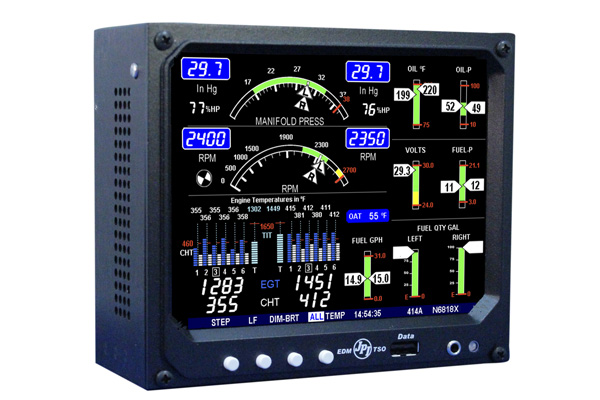 The installation and maintenance of the EDM 960 Twin Engine Management System must only be carried out by certified aircraft maintenance engineer.
The installation and maintenance of the EDM 960 Twin Engine Management System must only be carried out by certified aircraft maintenance engineer.
The EDM-960 Display Installation
Before you install the EDM 960, located your fuel quantity calibration records as the installation engineer might need to refer to it at time of installation of the EDM 960. Also, before you install the EDM 960, it might be a good idea to spend a few minutes in the cockpit and decide on exact location of the EDM 960 display. The best recommendation is to install the display within the natural scan and easy reach of the pilot.
When you have figured out the exact location where you want the EDM 960 placed, insert the special key card that came with the unit. Each unit is paired with a specific key card that has been pre-fed with data specific to your aircraft make and type.
EDM-960 Key Card Installation
Once the key card is inserted into the special slot in the unit, leave it in place and do not remove the card. When the aircraft engine is switched on, the Remote Auxiliary Display (RAD) of your EDM unit, will display the aircraft make and model in the right engine RAD. The Left side will simply display “EDM-960”.
To install the key card, open the small access flap located on the side of the EDM-960 display. Hold the Key Card so that the UP arrow is facing up and insertion arrow is facing to the right. Now insert the Key Card in the guide rails until you feel it snap into place. Close the access flap.
Power up the EDM and confirm that your aircraft make and model is displayed in the RAD. Install the EDM back into the aircraft.
Power Connection:
The EDM-960 accommodates 14V or 28-volt electrical system. When installing the Aircraft Engine Data Management 960, care must be taken to ensure that the master bus power must be individually provided via three, 5-Amp circuit breakers, to the two DAU units and the EDM-960 head. The DAU ground wires should be connected to the engine block.
The Twin Engine Mgmt Systems EDM 960 Twin is comes with Teflon insulated wiring harness configured for the correct number of cylinders for your aircraft. Each wire harness is marked C1= CHT-1, E1= EGT-1 and so forth.
Post-Installation Trouble Shooting / maintenance:
1.On start-up, a missing column of figures in the display would indicate that the continuity check diagnostic routine has found an open line or probe with no connection. An error message will indicate which cylinder to look at.
2.A missing column of figures during flight indicates a reading that is jumping around or incorrect. Solution: Remove the probe from the line up to prevent false alarms.
3.A negative reading (-) in front of the number indicates reverse polarity on the red/yellow wire to probe.
4.Erroneous or erratic readings on one cylinder reading. Solution: Swap the suspected probe with a probe from a good cylinder. If the problem is transferred to the good cylinder then the probe is faulty and should be replaced. If the problem remains the same, it is in the Thermocouple hook-up wiring from the EGT Probe to the instrument or it can be in the ring terminals crimped to the wire.
5.If the temperature reading is changing more than 500°F in one second a loose wire crimp or Probes & Aircraft Sensors could be the problem. A malfunctioning probe will automatically be removed from the scan.
For more information, please visit: https://www.jpinstruments.com/shop/edm-960/

